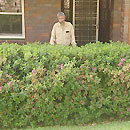About 10 months ago Don reworked an azalea hedge that had grown so tall it was blocking the light and obscuring the view from the house. The pruning was done in late spring, after the main flush of flowers had finished. In order to reshape the hedge it had to be cut right back to bare branches, so when the job was finished the hedge looked leafless and very ugly. Recently, the ‘Burke’s Backyard’ team revisited the same property to see if the azalea hedge had survived the renovation pruning.
The hedge is now thriving and is covered in lush, new growth. As Don predicted, the azaleas have not flowered much this year. However, next spring he expects that there will be a wonderful flower display along with the fabulous new shape. In the meantime Don recommended that the hedge be mulched with well-rotted cow manure, and fertilised with a mixture of 50% Nitrosol and 50% Seasol using a hose end applicator (this mixture stimulates both leafy growth and root growth). He also suggested giving it a light trim in January or February to maintain the new shape and encourage further dense new growth.
Azalea lace bug
The azalea hedge had been attacked by azalea lace bug. This pest appears in spring and sucks sap from new growth on azaleas and rhododendrons. Early spraying to prevent damage is usually necessary, as damaged leaves look ugly for a long time. Preparations to control azalea lace bug (such as Bayer Confidor) are available at hardware stores and nurseries.
Further information
Nitrosol and Seasol are readily available at hardware stores and nurseries. 1 litre of Seasol or Nitrosol concentrate costs about $16 to $20 and makes up to 350 litres.



